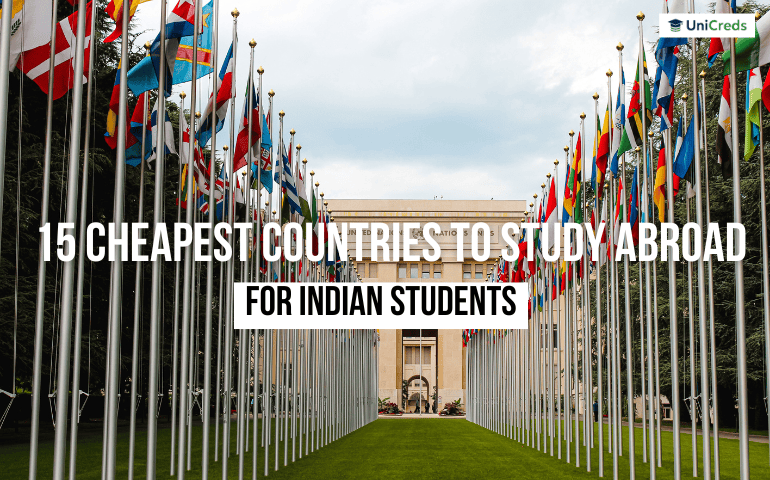Table of Contents
If you have a vision of the American dream to study in a US university, you might just be aware that education in the States can be quite expensive, especially for international students including travel costs, fees, living expenses, etc. But this should not deter you from pursuing a college degree in the US as some schools provide need-based financial aid and a few offer need-blind admissions. The number of need-blind colleges for international students is relatively lesser, though. In this article, we will provide you with a guide to need-blind admission.
What is Need-blind Admission?
In a need-blind admission procedure, the students are evaluated without any importance or consideration given to their families’ capacity to fund their education and the focus is solely on their merit and qualifications. This ideally applies to all need-blind colleges.
Click Here to Know About Abroad Education Loan
Need-Blind vs Need Aware Colleges
Need-Blind vs. Need-Aware Colleges -There are a lot of fundamental differences between ‘need-blind’ and ‘need-aware’ admission policies. As their names indicate, need-blind admission policies in all need-blind colleges do not take into account a student’s financial status and focus solely on his merit and qualifications while need-aware colleges take into account the student’s financial status and ability to fund his or her own education at some point in the evaluation process, even if it is not the sole criteria for admission. Some of the famous need-blind colleges for international students are Boston College, Brown University, Dartmouth College, Duke University, MIT, etc.
Does Need Blind Admission Guarantee Fully Funded Education?
Not really. Even if the institution in question does offer financial aid to students, you will be expected to make a few financial contributions to your education calculated based on an analysis of your parent’s income, your income, and your other financial resources. It is possible that you may also be expected to participate in a work-study program or a part-time job to cover a part of the costs. That said, most students enrolled via a need-blind and full-need policy benefit a lot from the high amounts of scholarship money or grants they receive.
Top Need-Blind Colleges For International Students
Approximately 15 universities in the USA practice need-blind admissions, yet only a few universities extend this policy to international students. Below is a list of top Need-blind universities in USA for international students
| University | Location |
|---|---|
| Massachusetts Institute of Technology (MIT) | Cambridge, MA |
| Harvard University | Cambridge, MA |
| Princeton University | Princeton, NJ |
| Yale University | New Haven, CT |
| Georgetown University | Washington, D.C. |
| Dartmouth College | Hanover, NH |
| Bowdoin College | Brunswick, ME |
| Amherst College | Amherst, MA |
| Pomona College | Claremont, CA |
Keep in mind that many other US colleges and universities also offer generous grants and scholarships to deserving students under various policies, so even if they don’t have an official need-blind policy, do not hesitate to apply to them. You can calculate the estimated expenses using their net price calculator and determine how to meet the expenses with your available funds and resources.
What Types of Financial Aid Policies Do Need-Blind Universities Offer?
Need-blind universities each have their own unique financial aid policies, so it’s essential to reach out to each specific institution for detailed information. However, in general, need-blind universities tend to fall into one of three categories when it comes to financial aid:
1. Category 1: Full Need, No Loans Schools
These schools promise to cover a student’s demonstrated financial need entirely through financial aid opportunities without requiring any student loans. This is particularly beneficial since many students graduate with significant debt. In 2022, the average student debt was approximately $37,693, and this amount is expected to increase due to rising tuition costs. Full need, no loans schools aim to provide an excellent education without burdening students with post-graduation loan repayments, which is especially crucial for moderate- to low-income students.
It’s worth noting that these schools guarantee to cover a student’s “demonstrated financial need,” which is the difference between tuition costs and what a student’s family can contribute.
2. Category 2: Full Need With Loans Schools
Need-blind universities in this category also commit to covering 100% of a student’s demonstrated financial need through a financial aid package, but they may include loans along with grants, scholarships, and work opportunities. For example, if a student’s demonstrated financial need is $38,000, a “full need with loans” school will provide financial aid that covers the full amount, including a Stafford Loan, which results in a small amount of student debt upon graduation.
3. Category 3: No Guaranteed Financial Aid Schools
Some need-blind universities adopt a need-blind admissions policy but do not guarantee financial aid to cover a student’s demonstrated financial need. Instead, the financial aid package may leave a gap that the student must fill beyond their family’s contribution. For instance, if a student’s demonstrated financial need is $25,000, and the school’s financial aid package covers only $20,000 (80%), the student will need to find alternative ways to cover the remaining $5,000, such as private loans or part-time employment.
It’s important to remember that these categories provide a general framework, and specific policies may vary from one need-blind university to another. To gain a clear understanding of the financial aid options available to you, be sure to reach out to the admissions and financial aid offices of your chosen school.
What Criteria Should You Consider When Choosing a Need-Blind College?
Now that you have a grasp of what a need-blind university entails and its financial implications, here are three key factors to keep in mind when evaluating potential need-blind colleges:
1. Ensure the School Aligns With Your Goals
Need-blind colleges are reputable institutions known for offering substantial financial assistance to eligible students. However, it’s paramount to select a college that aligns with your academic and career aspirations. While a need-blind college may seem appealing on the surface, if it doesn’t provide the majors or opportunities you’re passionate about, it’s advisable to explore other universities as well.
2. Examine the School’s Financial Aid Calculator
Every college offers its own tuition calculator to help you estimate the actual cost of attending. For instance, Yale University and Tulane University have their tuition calculators. Although these tools won’t precisely predict your financial aid package, they will clarify the portion you need to cover out of your own pocket. It’s crucial to utilise each university’s tuition calculator since many schools, particularly elite ones, employ their unique formula to determine your demonstrated financial need.
3. Stay Open to Applying to Your Dream School
Keep in mind that your FAFSA and tuition calculator results aren’t definitive indicators of your potential financial aid package. If the numbers from these forms appear higher than what you can afford, don’t be disheartened. Universities evaluate individual financial needs on a case-by-case basis, so your actual financial aid package could be more generous than you anticipate. Additionally, remember that these calculators don’t account for external scholarship opportunities, which can further reduce your expenses.”
FAQs
1. What colleges are truly need-blind?
Some of the truly need-blind colleges are MIT, Harvard University, Princeton University, Yale University, and Amherst University.
2. .Are there any scholarships or financial aid opportunities for international students at need-blind colleges?
Universities in the USA that practice need-blind admissions admit students and provide financial aid regardless of the applicant’s financial circumstances.
3. What’s the difference between need-blind and need-aware colleges for international applicants?
In need-blind colleges, admission policies are solely based on a student’s merit and qualifications, without considering their financial status. In contrast, need-aware colleges take into account a student’s financial circumstances and their ability to financially support their education at some point.
4. How competitive is the admission process for international students at need-blind colleges?
Considering that most need-blind universities in the US are prestigious institutions, it’s probable that their admissions processes are highly competitive.
5. Can international students apply for full financial aid at need-blind colleges?
Yes, some need-blind universities enable international students to be evaluated for admission solely on the basis of their academic merit and achievements.
We hope you enjoyed reading this blog on the need-blind colleges for international students. To know more about related fields, check out our other blogs.










0 Comments